Aeonium arboreum



Soft wooded
No secondary (woody) tissue being formed. The texture is fleshy and is soft, easy to cut.
Clumping
A plant that when multiplies forms a clump.This subtropical succulent sub-shrub has an upright habit with fleshy stems that branch occasionally. The spoon-shaped fleshy mid-green leaves are arranged in rosettes towards the end of the stems and star-shaped yellow flowers bloom during summer.
Aeonium arboreum (L.) Weeb & Berth. is naturally found in Gran Canaria island in the Canary Islands, Spain growing on rocky mountain sides and along the coast up to an altitude of 1,000 m (3,280 ft) or more. It has now naturalised from Morocco (Northern Africa) and the southern Mediterranean islands to Northern South America and California. It grows in very well drained moderately fertile sandy-stony calcareous or gritty loamy soils that are neutral tending alkaline with a pH range from 7.0 to 8.5. It grows in an open sunny position but will tolerate semi-shade and is drought-heat tolerant but frost tender with a preferred minimum winter temperature of -2ºC (28ºF).
The Tree Aeonium is grown for its attractive foliage, upright habit and dense flower heads. It is planted arid or Mediterranean gardens in rockeries or along sunny borders and is commonly used in patio pots and planter boxes, tolerating hot dry conditions. It as a vigorous growth rate and establishes from cuttings in 2 to 3 years and is moderately long-lived. In cold regions it is grown as a glasshouse or conservatory specimen and can be used as a house plant in a sunny location. It has a low water requirement once established (Scale: 1-drop from 3) preferring to have dry soil before watering and dislike wet conditions.
I.D. 1341
UK hardiness zone H1c
Climate zones 15-17, 20-24
USDA Zone 9-11?
Aeonium (ee-O-nee-um) arboreum (ahr-BOR-ee-um)
Etymology
Genus: Latin - Aeonium – a name that was used by Dioscorides to describe a genus of succulents
Species: Latin – arboreum – meaning (tree-like) referring to the growth habit of the plant
Cultivar
'Atroppurpureum'
This cultivar has dark purple leaves and is simular to 'Zwartkop' but lighter in colour.
'Velour'
This cultivar grows to 600 mm (2 ft) tall and wide forming a bushy habit with rosettes of green to dark burgundy or variegated foliage and produces yellow flowers during summer. It grows in a semi shaded to sunny position tolerating drier conditions and grows in USDA zones 9-10.
'Variegatum'
This plant has a branched upright habit to 600 mm (2 ft) tall and has pale green leaves with a broad creamy margins that appear in a terminal rosette. It produces tiny creamy flowers during spring.
'Zwartkop'
This plant has purplish black coloured leaves.

Spain (Canary Islands)
Crassulaceae (krass-yoo-LAY-see-ee)
Stonecrops and Houseleakes
This family consists of perennial soft wooded herbs (succulents) and small shrubs.
Distribution
Mainly found in warm temperate climates but mainly in warm dry regions of South Africa, Madagascar and Central America. Others are founds in frosty or moist regions.
Diagnostic features
The leaves are arranged opposite or spiral in a tight rosette and commonly fleshy with entire margins and no stipules. The leaves are commonly specialised for xerophytic conditions by having the surface covered in wax, hairs or bristles. In many cases they can reproduce vegetatively from fallen leaves, offsets and adventitious buds.
The bisexual flowers are composed of three; four and five parts with free fleshy sepals and membranous petals that may be fused at the base.
The stamens are arranged in 1-2 whorls with a fleshy nectar gland that are opposite each carpel. It may have a short or long style.
The ovary is superior with carpels that are fused or free and number the same as the petals and have numerous ovules in each.
The fruit is normally a star shaped or group of follicles with many tiny seeds that have little or no endosperm.
Note:
Many species are cultivated in containers or garden beds and under glass in cool areas. They are very popular with gardeners as they are easily propagated from cuttings and are adapted to dry conditions.
Plants are classed as succulents as they resemble each other. They have fleshy leaves and stems, which can store water. There are three families, Cactaceae, Crassulaceae and Mesembryanthemaceae in which all the species are succulents.
Most of the succulents are indigenous to semi-arid environments with long dry periods followed by a short wet period. The plants swell absorbing water during these wet periods and reduce evaporation by having a waxy cover over the leaves or the leaves are crowded together in a rosette. Hairs and spines (modified leaves) also reduce the evaporation of water and most succulents form rounded shapes to reduce the surface area of the plant.
The size of the plant and flowering period is difficult to predict with succulents as the environmental factors such as weather and light variations control the flowering period. Soil type and available moisture influence the growth.
This plant tolerates between USDA zones 9a to 11a and grows to 1.5 m (5 ft)
Fahrenheit 20º to 45º F
These temperatures represent the lowest average.
Celsius -6.6º to 7.2º C

Attention
This plant was last revised on the 30/05/2019
The information displayed on this plant is based on research conducted in our horticultural library and from reliable online resources. We also make observations of the plant that we photograph, and all care is taken to ensure the details are correct.
All photographs and data are covered by copyright. Apart from any fair dealing for the purpose of private study, research, reference or review, as permitted under the Copyright Act, no part including images and text may be reproduced by any means without written permission. The information presented in the map is only indicative and may contain errors and omissions. All inquiries should be addressed to sales@plantfile.com attention Peter Kirkland.
.

Simple
The leaf that is not divided.
Spathulate
A leaf that is broad and rounded at the apex tapering to the base (spoon shaped).
Rosette
A cluster radiating from a common source.
Entire
A leaf margin with no irregularities (smooth).
Stellate
When the petals radiate from a common centre forming a star-shape.
Panicle
Branched with large loose clusters.| Jan | Feb | Mar | Apr | May | Jun |
| Jul | Aug | Sep | Oct | Nov | Dec |
The small stellate flowers are arranged in a terminal panicle up to 300 mm (12 in) long and held above the foliage on a tall scape appearing during summer. Once the flower has finished the branch dies back.

Follicle
A capsular fruit that splits open down one side only and normally contains one seeds. "The Tree Aeonium is grown for its attractive foliage, upright habit and dense flower heads. It is planted arid or Mediterranean gardens in rockeries or along sunny borders and is commonly used in patio pots and planter boxes tolerating hot dry conditions. It as a vigorous growth rate and establishes from cuttings in 2 to 3 years and is moderately long-lived. In cold regions it is grown as a glasshouse or conservatory specimen and can be used as a house plant in a sunny location.
Cultural notes:
Outdoor cultivation
In warm regions with low humidity, cold and frosty nights with hot sunny days cacti and succulents grow well outdoors. The more humid atmosphere will limit the number of successful species. All of these plants require a very well drained soil and ample sunlight to succeed. Once established these plants require minimal maintenance.
Indoor cultivation
Cacti and succulents grow well in glasshouses or near a sunny window with some ventilation tolerating a marked difference in day and night temperatures.
Cacti have a rest period during mid winter when they can be stored in a cooler area with reduced watering, once every two months. Protect the plants from freezing temperatures or extreme direct hot sunlight behind glass. All plants prefer a period outdoors during summer.
Watering
These plants normally have wet and dry periods. Watering should take place during the growing period of the plant. When new growth appears water well once a week and never water if the soil is already wet or place the pot in a saucer of water. Free drainage is essential for a healthy plant and succulents rot easily in moist humid conditions.
Problems related to watering
Over watering succulents results in leaves that wilt and discolour or stems that rot.
Under watering results in a sudden loss of leaves or brown and dry spots on the leaves. Leaves also fall if the water is too cold.
Pots
Both clay and plastic pots are suitable. The pot should fit the plant comfortably and not be too big as it may remain moist, rotting the plant. Water only when the soil has dried.
Re-pot only when necessary in to a slightly larger pot for older plants. If the plants are very large replenish the surface soil and thoroughly water.
Sow fresh seeds during spring and maintain a temperature of 18º to 21º C (64º to 75º F). Take stem cuttings during summer and allow the wound to callus then place in a sandy mix and occasionally water allowing roots to form.
Propagation by seed (General)
Germination
In order for a seed to germinate it must fulfil three conditions.
1. The embryo must be alive (a viable seed).
2. The seed must have no dormancy-inducing physiological, physical or chemical barrier to germination; also the seed must be nondormant.
3. The seed must have the appropriate environmental requirements, water, temperature and oxygen.
The interaction between these requirements and dormancy is complex and may lead to different environmental requirements that avoid the dormancy of a seed.
Sowing seeds in containers
There are two general methods for germinating seeds.
Sow seeds in a flat or germinating bed, through which seedlings are pricked-out then, transplanted into another flat with wider spacing or directly to an individual pot.
2. Sowing seeds by placing them in to flats with the appropriate spacing or into individual pots.
This method is normally carried out with medium to large seeds such as woody plants and plants that are difficult to transplant.
Seedling production normally occurs in a greenhouse / glasshouse, cold frames and on hot beds.
Method of seed sowing
Fine seed is sown in pots or flats that are no deeper than 70 to 80 mm (3 1/8 in). using a sterilised well-drained media (soil). Fill the container to 20 mm (¾ in) from the top and sprinkle sieved peat to 3 mm (1/8 in) depth. Press the media down level and firm with a piece of timber and then thoroughly moisten.
Mix the fine seed with washed sand and then sow thinly on the surface. These may be lightly covered with sand.
Larger seeds may be covered with media or a hole is dibbled and the seed is placed in the media.
Watering methods
For watering you may either mist the containers from above or place the container in tepid water and allow the water to raise through the pot to the surface of the media, then drain away and do not fill to the top of the container.
Place a piece of glass over the pot and store in a protected warm environment (glasshouse).
Seeds germinate best in darkness so shade the containers if in direct sunlight.
After the seedlings have sprouted remove the glass and ease the seedlings into direct light.
When the seedlings are large enough prick them out and transplant into larger containers then place them in a shade house to harden off.
Many seeds have different methods of seed preparation for germination such as nicking or cutting the seed coat to allow water penetration, also placing seeds in hot water and allowing it to cool off.
This is particularly important as it is softening the seed coat.
Asexual propagation (Cuttings general)
Propagation from cuttings is possible because every cell of a plant containers the genetic information to create an entire plant.
1. Reproduction occurs through the formation of adventitious roots and shoots.
2. The uniting of vegetative parts with budding and grafting.
3. Taking stem cuttings and layering is possible due to the development of adventitious roots
4. Root cuttings can form new shoots then it is possible to join roots and shoots to form a new plant.
5. A new plant may be formed from a single cell in an aseptic culture system, (cloning).
It is important to propagate vegetatively as this form of cloning retains the unique characteristics of the cultivars or where particular aspects of a plant may be lost if propagated by seed.
Equipment required for taking cuttings
1. A sharp knife that is not too large or a razor mounted in a handle.
2. Good pair of sharp secateurs that is clean.
3. A dibbler to make a hole in the media and allow the cutting to be placed in.
4. Propagation structures that are either a timber frame with glass or polyethylene cover or a glasshouse.
The object of the structure is to create an environment where the temperature and humidity can be controlled. This can be achieved with a simple cover over a pot with a wire frame and plastic.
This stops the draughts and maintains humidity.
5. A hotbed is a useful item as many plants root more quickly if the media is slightly warmer.
Bottom heat is obtained from thermostatically controlled heating cables that are running under the media.
6. Misting systems are of great benefit to cuttings as the regulated fogging with water inhibits the cuttings from drying out and as a result the cuttings may be grown in full sun.
This results in faster root development that is less subject to diseases by fungi and bacteria.
7. Rooting mediums
The rooting medium must be well drained, sand may be used as long as it is thoroughly washed and leached of all salts. It is very well drained and it is excellent for cutting that root up quickly. Equal parts of sand and peat moss have good results for cuttings, which are left for a period of time to allow the roots to form.
Vermiculite and perlite are also used as a well-drained rooting media but has the same disadvantage as sand having no nutrients. The cuttings must be potted up as soon as the roots developed, or a light application of liquid fertiliser can be applied.
Types of cuttings
Stem cuttings
These are the main types of cuttings.
1. Softwood cuttings
These cuttings are taken from young growth on side shoots and tip growth.
2. Semi hardwood cuttings
These cuttings are taken from wood that is firmer and semi ripe usually during mid summer.
3. Hardwood cuttings
These cuttings are taken from mature wood normally towards the end of the season.
4. Root cuttings
Cut sections of roots to obtain new plants during late winter to early spring.
5. Leaf cuttings
Cut the leaf blade in order to obtain new plants during the growing period of the plant.
Cutting preparation
Hardwood cuttings
When taking hardwood cuttings remove the leaves and in semi hardwood reduce the number of leaves by half. Cut the wood straight across just below a node or joint. Hardwood cuttings are normally between 100 to 760 mm (30 in) long and may have either a heel of the older wood attached to the base, or a short section of the older wood at the base. These cuttings are prepared during the dormant season from late autumn to early spring and are made up from previous season's growth.
This type of cutting is used for woody deciduous plants such as Crepe Myrtle, Rose rootstocks and some fruit trees.
The cuttings should be healthy wood with ample supply of stored food as to nourish developing roots, shoots and placed in the rooting media with the aid of a dibbler stick.
Softwood cuttings
The cuttings for softwood should be 60 to 130 mm (5 1/8 in) long and be of material with enough substance as to not deteriorate before the new roots appear. Cut below a node and retain the leaves on the upper portion. Place in a well-drained media and maintain a high humidity.
Soaking the cuttings and leaving them standing in water for long periods is undesirable.
Herbaceous cuttings
These cuttings are taken from succulent plants such as Geraniums and Coleus. The cutting should be 70 to 130 mm (5 1/8 in) long with leaves retained on the upper end. As in softwood cuttings these require an environment of high humidity. Some fleshy cuttings ooze sap and may require a drying period for a few hours before being placed in the rooting media.
Leaf cutting
In these cuttings a leaf blade and petiole or part off is used to raise a new plant. The original leaf doses not become a part of the new plant as roots and shoots appear from the base of the leaf. In some cases roots appear from the severed veins.
Leaf-Bud cuttings
These cuttings incorporate a leaf, petiole and a small piece of the stem. These cuttings are an advantage where the plant uses the axillary bud at the base of the petiole for new shoot growth and maximises available propagation material, as each node will produce a new plant.
As in softwood cuttings these require an environment with high humidity and warmth.
Root cuttings
These cuttings are best taken from younger plants during late winter to early spring prior the new season's growth unless the dormant period is during summer.
Trim the roots as they are dug up, to maintain polarity cut strength at the crown end and a slanted cut at the distal end (away from the crown).
Root cuttings of small plants are placed in flats in lengths of 20 to 50 mm (2 in) and laying horizontally on the surface of the soil. These may be lightly covered with sieved sand or media, watered and then placing a piece of glass or polyethylene over the container till roots / shoots appear.
Fleshy root cuttings
These cuttings should be 50 to 75 mm (3 in) long and placed vertically in a well-drained sand media.
Keep the polarity correct and when the roots develop transplant the cuttings into a separate container.
Large root cuttings
These cuttings are 50 to 150 mm (6 in) long are tied up in bundles and placed in boxes of damp sand, sawdust or peat for about three weeks at a temperature of 4.5º C. When taken out they should be planted in a prepared bed 50 to 80 mm (3 1/8 in) apart with the tops of the cuttings level with or just below the soil level.
PEST
NAME
Whitefly, Snow flies
Various Whitefly Species
ORDER
Hemiptera
FAMILY
Aleyrodidae
Description of the Pest
This is a small sap sucking moth-like insect up to 3mm long with winged adults that have a covering of fine white powder, hence the common name. The wings are folded flat over the body and males live for one month and females live up to three months. The eggs are laid on the underside of the leaf and the wingless nymphs are immobile, flattened-round scale -like with a fringe of waxy filaments. The nymphs are translucent to greenish, congregating on young plant tissue and both adults and nymphs suck sap and producing honeydew.
There are several species such as Ash whitefly (Siphoninus phillyreae), Tobacco whitefly (Bemesia tabaci), Silverleaf whitefly and Spiralling whitefly (Aleurodicus disperses)
Greenhouse whitefly (Trialeurodes vaporariorum)
This species of whitefly normally grow to 2mm long with two pairs of wings. Their colour is due to a covering of a fine white wax and the insect has a white-moth appearance. If disturbed the insects swarm and resettle on the plant quickly. The first nymphal stage is mobile and the later stage is scale-like with fine waxy marginal hairs. These nymphal stages produce honeydew, which encourages sooty mould. It is a persistent pest commonly found in glasshouses.
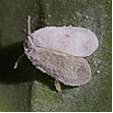 Adult
Adult 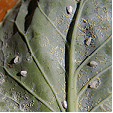 Appearance under the leaf
Appearance under the leaf
The Hakea Whitefly (Synaleurodicus hakeae) is a small, moth-like up to 0.15mm wide with wings that have a powdery coating and produce flattened scale-like nymphs. Both adult and nymph gather together in colonies and suck sap.
Appearance and Distribution of the Pest
The eggs are laid during the spring and the adults tend to stay on the underside of the leaf until disturbed, when they fly in mass and may infect other plants. Many plants are only susceptible to this insect when cultivated under glass.
Life Cycle
This insect has a Hemimetabolous life cycle, ie. When the immature nymphs resemble the adults.
White flies have a gradual metamorphosis, egg and four nymphal stages. One generation occurs from three to eight weeks and is dependant on the current weather. Hundreds of eggs are deposited on the underside of leaves in arch or circles each with a short stalk.
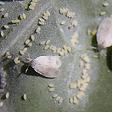 Eggs laid in a pattern
Eggs laid in a pattern 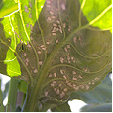 Eggs laid in a pattern
Eggs laid in a pattern
After hatching the first nymphal stage wanders around on the leaf surface for several days. Then selects a place to suck sap where it goes through all nymphal stages emerging as an adult after the fourth stage.
Period of Activity
This peat is found from tropical to temperate regions and is most active during warm weather. It is difficult to predict an infestation, as some years it is severe and other years it is absent. In glasshouse conditions it is often a problem and may extend outside the normal period of activity. They overwinter in the egg stage or find sheltered places to hide.
Damage Caused
Affected plants have leaves with yellowish to white mottling on the upper surface or with shiny secretions on new shoots or on the underside. Heavy infestations cause leaves to wilt and sooty mould to appear on the honeydew. Plant looses vigour and in some cases die.
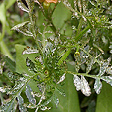
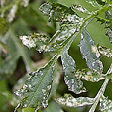 Tagetes erecta
Tagetes erecta
Susceptible Plants
Whiteflies attack a wide range of plants affected by this insect, including Abutilon, Boronia, Hibiscus and Fuchsia species. Citrus, Vegetables, Ferns and certain weed species are venerable. Australian native plants are also attacked, such as the Hakea species.
Greenhouse whitefly (Trialeurodes vaporariorum) attacks a wide range of ornamental plants, weeds and vegetables including; Phaseolus (beans), Lycopersicon (tomatoes), potatoes, Cucumis (cucurbits), Lactuca (lettuce), Dendranthema (Chrysanthemum), Dahlia and Hibiscus species.
Several ferns, including Adiantum, Asplenium, Davallia, Nephrolepis, Onychium, Platycerium and Pteris species are attacked with nymphs congregating on the underside of the fronds, normally causing little damage.
Rhododendron species are attacked by the Rhododendron White Fly (Dialeurodes chittendeni) causing yellowish mottled appearance on the upper surface of the leaf.
Cultural Control
It is difficult to control with out the application of chemicals, though strong jets of water greatly disturb the colonies. Companion plantings with basil or other aromatic plants deters white flies or spray the plants with onion-garlic spray.
In an enclosed environment sticky fly paper can reduce numbers. When the nymphal stage is found an application of white oil will reduce numbers.
Biological Control
A parasitic wasp (Encarsia Formosa) attacks nymphal stages reducing numbers. Other predators include small birds, spiders, ladybirds and there lava, hover flies, damsel flies and mantids.
Chemical Control
Plants may be sprayed with Dimethoate, permethrin, bifenthrin or pirimiphos-methyl, but some insects have immunity to chemicals. The pest may also be sprayed with a mixture of white oil and nicotine sulphate or pyrethrum.
Note
Always read the label for registration details and direction of use prior to application of any chemicals.
PEST
NAME
Aphids
Various Aphid Species
ORDER
Hemiptera
FAMILY
Aphididae
Description of the Pest
The common name varies and aphids may be referred to as black fly, greenfly, ant cows or plant lice.
These small insects have soft globular body that is from 1mm to 8mm long and vary in colour from green, yellow, black and pink, with the winged forms being elongated. Both adult and nymphs, have piercing and sucking mouthparts.
Aphids are found on buds, flowers, or leaves and stems, preferring soft new growth. On older leaves the aphids are found in protected positions, such as under the leaf. Certain species of aphids form galls as they suck sap and may be found on the roots of the plant. (E.g. Woolly aphids and Black peach aphids)
Most aphids possess a pair of characteristic tubular projections, known as cornicles; these secrete a pheromone and a waxy fluid, which is thought to protect them from some of their predacious enemies.
White exoskeletons, honey dew and sooty mould indicate the presence of Aphids
Balsam Twig Aphid (Mindarus abietinus) is greenish and covered in a white wax and is normally found on the young shoots of conifers bending and killing the needles. It is found on Abies and Picea species.
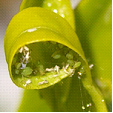 Aphid and their exoskeletons
Aphid and their exoskeletons 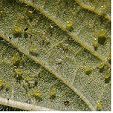 on underside of a leaf
on underside of a leaf
Black Citrus Aphid (Toxoptera aurantii) has a soft plump green body and the black coloured adults may or may not be winged. They feed in groups, curling leaves and producing honeydew attracting sooty mould.
Green Peach Aphid (Myzus persicae) is a soft plump green insect up to 0.2mm long and may be wingless. The nymphs are yellowish green and are responsible for spreading viruses in Dianthus species.
Spruce Gall Aphid (Chermes abietis) form cone shaped galls up to 12mm long resulting from the feeding. The wingless female adult lays eggs on the stems and the immature females overwinter on bud scales. Large infestation will weaken trees such as Picea abies and Pseudotsuga menziesii.
Tulip Bulb Aphid (Anuraphis tulipae) is small, waxy grey coloured and infests the underside of the bulb scales or rhizomes. They occur in the ground or on above ground parts and during storage.
Life Cycle
These insects have a Hemimetabolous life cycle, i.e. The nymphs resemble the adults.
During spring all eggs produced hatch as female nymphs. Adult Aphids are capable reproducing without fertilisation. The males are only produced in some species as the weather cools down, and the day length shortens.
Aphids are capable of giving birth to living young and large populations build up quickly during summer. Over crowding causes the aphids to become smaller, less fertile and produce more winged forms that can migrate to other host plants.
There are many different types of aphids and the life cycle varies from warm to cold climates.
Typical life cycles
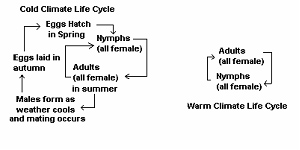
Distribution of the Pest
World wide
Period of Activity
In warm climates they are seen throughout the year, but aphids dislike hot dry or cold conditions and heavy rain will decrease the population. In cold areas aphid eggs are laid around a bud base or other protected areas of the plant during autumn and emerge as nymphs during spring, feeding on the new growth.
Numbers build up quickly in the warmer months of the year. Some species feed during winter on Sow thistles.
Susceptible Plants
There is a wide range of plants attacked, from roses to vegetables, shrubs and trees. Certain aphids attack a specific genus while others have a wide range of host plants. Many are capable of transmitting plant virus diseases.
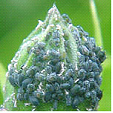 Adults and nymphs feeding
Adults and nymphs feeding 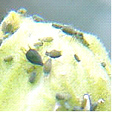 A colony of aphids
A colony of aphids
Acer species are attacked by several aphids including the Norway Maple Aphid (Periphyllus lyropictus) which is a greenish with brown markings and secret honeydew, preferring Acer platanoides. Other aphids include (Drepanaphis acerifolia) and (Periphyllus aceris) which are commonly found on the underside of leaves.
Acer species are also attacked by the Woolly Maple Aphid (Phenacoccus acericola) which covers the undersides of the leaves with a cotton-like mass
Alnus species are infested with the Alder Blight Aphid (Prociphilus tessellates) which is blue-black adult that forms woolly masses on the down-turned leaves. The nymphs overwinter in bark crevices.
Aquilegia species are attacked by several aphids including (Pergandeidia trirhoda) which is a small, flat cream coloured insect that is found on young branches and the underside of leaves.
Betula species may be attacked by the European Birch Aphid (Euceraphis betulae) which is small and yellowish or the Common Birch Aphid (Calaphis betulaecolens) which is large and green producing ample honeydew for sooty mold to grow on.
Callistephus species may be attacked by the Corn Root Aphid (Anuraphis maidi-radicis) causing the plant to become stunted, the leaves wilt and turn yellow. The aphids feed on the roots producing honeydew and are dispersed to other host by ants. It is also attacked by the Potato Aphid (Macrosiphum solanifolii).
Carya species are attacked by Gall Aphids (Phylloxera caryaecaulis) which is found on the leaves, twigs and stems forming galls and turning them black.
Chaenomeles and Gladiolus species, new growth and leaves become infested with the aphid (Aphis Gossypii)
Cupressus macrocarpa may become infested with the Cypress Aphid (Siphonartrophia cupressi).
Cyclamen species are attacked by the aphid (Myzus circumflexus) and (Aphis gossypii) which can infest healthy plants.
Dendranthema, Dianthus and Crocus species are attacked by several types of aphid including the Green Peach Aphid (Myzus persicae) and the Chrysanthemum Aphid (Macrosiphoniella sanborni).
Hibiscus species are attacked by the aphids (Aphis craccivora) and (Aphis gossypii), both congregate towards the branch tips and may cause leaf curl. Normally only seen in sub-tropical climates.
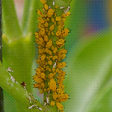 Aphids on a stem
Aphids on a stem 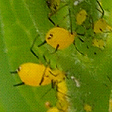 Mandevilla species
Mandevilla species
Larix species is attacked by the Woolly Larch Aphid (Adelges strobilobius). The winged adults deposit eggs at the base of the needles during spring and white woolly areas appear attached to the needles where the adult aphids feed. The young aphids overwinter in the crevices of the bark.
Mandevilla species is attacked by aphids that congregate towards the branch tips and may cause leaf curl.
Pinus species is attacked by several species of aphid including Pine Bark Aphid (Pineus strobi), Pine leaf Aphid (Pineus pinifoliae) and the White Pine Aphid (Cinara strobi).
Primula species are attacked by four species of aphid including foxglove, and green peach aphid.
Rudbeckia, Delphinium, Chrysanthemum and Helianthus species are attacked by a bright red aphid (Macrosiphum rudbeckiae).
Sorbus aucuparia is affected by the Rosy Apple and Woolly Apple aphid which attacked the foliage and young shoots.
Spiraea species are attacked by the Aphid (Aphis spiraecola) which feeds on the young shoots and flowers.
Tropaeolum species are attacked by the Black Bean Aphid (Aphis fabae), which is found in large numbers on the underside of the leaves, turning them yellow and causing them to wilt then die.
Tulipa, Iris, Freesia, Gladiolus and Zephyranthes species are infested with the Tulip Bulb Aphid.
Ulmus species are infected by two types the Woolly Apple Aphid (Eriosoma lanigerum), which curls and kills young terminal leaves and the Elm Leaf-Curl Aphid (Eriosoma ulmi) which occasionally attacks the trees.
Viburnum species are attacked by the Snowball Aphid (Anuraphis viburnicola). This aphid congregates at the end of the branches causing the leaves to curl and become deformed under which they hide.
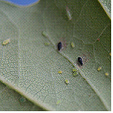 Aphids on Quercus robur
Aphids on Quercus robur
Damage Caused
Buds that have been attacked may not open, leaves and twigs become twisted or distorted and wilt. The aphids also produce honeydew, which is sticky and attracts sooty mould (fungus). This fungus forms a thick layer over the leaf, fruit or stems reducing the plants photosynthesis capability. The sooty mould spoils the plants appearance and its fruit, as does the insects white exoskeletons.
Control
Cultural Control
Aphids may be removed from a plant by hosing them off with water (limited success) or applying soapy water to aphids.. Another organic sprays can be efficient in controlling aphids. Aphids may also be removed physically by hand for small colonies on spine less plants. Species that live under ground are difficult to control but cultivation of the surrounding soil may help in controlling the infestation. (limited mainly to annual or commercial crops)
Reflective mulch around the plants also reduces numbers by repelling the insect this material is available commercially. (Reflective mulches are mainly used in market gardens for avoiding the Green peach Aphids) Resistant rootstocks are available to avoid some root feeding aphid of commercial plants, e.g. Vines and fruit trees
Biological control
Aphids are attacked by several insects includes parasitic wasps or predators such as ladybirds/ lady beetles, hover flies, lacewings, spiders.
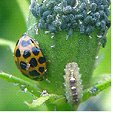
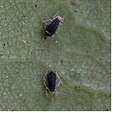 Parasitised aphids
Parasitised aphids
Chemical Control
Aphids may be controlled by spraying with a contact or systemic insecticide. The type of application used will depend on the plant is being attacked.
Aphids can be suffocated and therefore controlled with the use of e.g. White oil, Pest oil, Soapy water from soap such as Lux Flakes ®
Note
It is your responsibility by law to read & follow the directions on the label of any pesticide
Monitoring
Aphid are attracted by yellow colour and traps such as boards painted yellow and covered in glue or sticky substance will attract and trap the insects. There is also a commercially sticky yellow tape that can be attached to susceptible plants
Amendments by B. Sonsie Dip Hort Sc Burnley
DISEASE
NAME
Sclerotinia Rot, Crown Rot
Sclerotinia species
Description
A fungal problem that attacks plant parts causing them to collapse and rot, including flower, leaf and stems.
Symptoms
This fungus attacks all the above ground parts of the plant but commonly infects the stem at the base, where it forms a soft, light brown watery rot that spreads rapidly. Under humid conditions the rotted areas forms white fluffy mycelium on which black sclerotia up to 10mm long develop. These sclerotia also form within the stem in affected areas. When leaves are infected the tissue may brown and dry out, especially during arid conditions. The resulting affect of infection is the death of the plant.
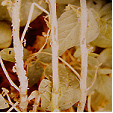
Image by B. Sonsie
Crown Rot (Sclerotium delphinii) causes leaves to turn yellow then become dry, and blossoms to wilt eventually killing the entire plant. It is found on Scilla, Viola and Delphinium species.
Flower Blight (Sclerotinia camelliae) infects flowers either by attacking the top of the petals forming brown specks or at the base of the flower where the petals turn brown then fall with out any sign of rot. The fungus develops on the fallen petals where microconidia are produced under moist conditions and eventually sclerotia appear. This form of the fungus can overwinter either above or below soil level until favourable conditions occur, then the spores are released and dispersed by wind.
Source and Dispersal
Sclerotia are found in the soil or on other infected plants and released spores are dispersed by wind.
Favoured Conditions
Prefers cool moist conditions with temperatures from 10º to 25ºC and is more common from autumn to spring when it is wet.
Affected Plants
A wide range of plants can be infected included French beans, peas, celery, cabbage, cauliflowers, carrot, parsnip, dahlia stocks, primula and many weeds.
Actinotus, Dampiera, Westringa species and Helichrysum bracteatum are infected by the Crown Rot (Sclerotinia rolfsii). Basial rot of the plant with cottony fungal growth and is associated with root congestion. Certain species of orchid may also be attacked.
Allium species are infected by the White rot (Sclerotium cepivorum) which is a major fungal disease of plants.
The bulb rot and are covered in mycelial which develop small black sclerotia (fruiting bodies) and infected plants may fail to produce flowering stem with the leaves become covered in a white mould, turning yellow then dieing off. It is commonly transmitted by infected seedlings and diseased plants should be burnt. Avoid re-planting Allium species in the infected soil where the spores overwinter. Soil may be infected for several years.
Antirrhinum, Aquilegia, Lobularia and Mathiola species are attacked by the Stem Rot (Sclerotinia sclerotiorum ) which infects the stigma travelling downwards through the flower into the stem where water soaked areas appear causing it to collapse. The flowers become pale and the entire plant may collapse. On inspection flat sclerotia may be seen in the stem.
Camellia species may be infected by Flower Blight (Sclerotinia camelliae) which causes blooms to fall and Stem Rot (Sclerotinia sclerotiorum).
Hyacinthus species can be infected by the fungus Black Slime (Sclerotinia bulborum) that causes the leaves to turn yellow then fall and bulbs to disintegrate.
Iris species are infected by the fungus Rhizome Rot (Botryotinia convoluta) that infects the rhizomes and forms black sclerotia, and is normally found on dieing plants during spring.
Turf Grass in warm climates is susceptible to Rolf's Disease (Sclerotinia rolfsii). The fungus infects the turf causing isolated dead patches up to 450mm across from spring to summer. As it progresses the dead patches increase in size and the white cotton-like mycelium can be seen in the underlying soil. It is not regarded as a major problem, with minor attacks on Cynodon dactylon (Couch) and Zoysia species.
Non-chemical Control
Initially remove and destroy any infected plants, when replanting, avoid using susceptible crops for 3 years. Space the plants to reduce the humidity and airflow and cultivate the soil to increase the drainage. Remove weed growth and leaf or flower litter from around the base of the plants to reduce the development of spores
Turf Grass culture such as aerating soil and maintaining a neutral pH helps prevent infection of Rolf's Disease.
Chemical Control
No suitable fungicides available, though drenching or spraying the soil with the fungicide dichloran helps control it.
Average Lowest Temperature : -1º C 30º F
USDA : 9, 10, 11
This USDA (United States Department of Agriculture) hardiness zone chart can be used to indicate a plant’s ability to withstand average minimum temperatures. However, other factors such as soil type, pH, and moisture, drainage, humidity and exposure to sun and wind will also have a direct effect on your plant’s survival. Use this chart only as a guide, always keep the other factors in mind when deciding where, when and what to plant.
A plant's individual USDA zone can be found in the Plant Overview.
Climate Description
Warm to Sub-tropical
This overlaping zone has ample rain with high summer temeperatures and high humidity. Winters are mild. Pockets of sub-tropical climates exist within coastal warm temperate zones.
Frosts and droughts rarely occur along the coast.
Plant growth
Tropical and warm temperate native and exotic plants grow well.
| Dictionary | Growth Habit |
| Leaf Type | Botanic Flower Description |
| Leaf Shape | Flower Inflorescence |
| Leaf Arrangement | Fruit Type |
| Leaf Margin | Bark Type |
| Leaf Apex And Bases | Flower Description |